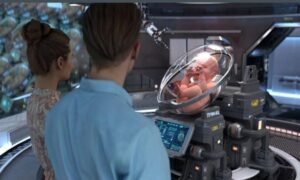Robot-Pregnancy: China’s Bold Leap Toward the First Robot Capable of Giving Birth
In recent years, science and technology have rapidly crossed boundaries once thought to be the preserve of imagination. Now, China is working on a project that may well become one of the most disruptive scientific milestones of the 21st century: the development of a humanoid robot capable of carrying and giving birth to a human baby. Dubbed “robo-pregnancy,” this innovation has captured global attention, sparking both excitement and unease about its potential impact on reproduction, healthcare, ethics, and society.
The Groundbreaking Vision
Dr. spearheaded the project. At the 2025 World Robot Conference in Beijing, Zhang Qifeng and his team from Kaiwa Technology in Guangzhou were shown to the audience. This ambitious project aims to incorporate an advanced artificial womb into a humanoid robot, in contrast to traditional artificial womb experiments that use laboratory settings.
This robot is made to look like the body’s environment during pregnancy. A fluid-filled chamber resembling the amniotic sac is supported within its artificial womb by nutrient delivery systems that replicate the function of the umbilical cord. Fetal growth would be monitored by sensors and AI-based monitoring, which would adjust hormone signals, oxygen levels, and nutrients to maintain development.
The ultimate goal is not only to carry a fetus to term but also to enable the robot to deliver a live baby—an achievement that would redefine reproduction.
Scientific Foundations
China’s project builds on decades of research into artificial wombs. In 2017, scientists in the U.S. successfully sustained premature lambs in “biobags” for weeks, demonstrating that artificial gestation was possible for limited developmental stages. More recently, Chinese researchers advanced artificial womb experiments with animal embryos, claiming encouraging results in early gestation studies.

What makes the current project unique is its integration into a humanoid robot. Unlike static laboratory devices, the humanoid form is intended to simulate not just the physical environment but also the external interaction that may influence development. The robot could move, respond to stimuli, and perhaps one day mimic maternal interaction, although replicating the emotional bond of human motherhood remains far more complex.
Potential Benefits
The implications, particularly for reproductive health and medical science, of robo-pregnancy are staggering:
Solution for Infertility: Nearly 15% of couples worldwide experience infertility, and the problem is exacerbated by social pressures and demographic concerns in countries like China. For those who are unable to conceive or carry a child naturally, robot-pregnancy may offer new hope.
Alternative to Surrogacy: Surrogacy is costly, contentious, and frequently subject to legal restrictions. Robot-pregnancy could provide a more accessible and controlled option at a fraction of the cost. The initial prototypes may cost around $13,900, which is significantly less than international surrogacy.
Reducing Pregnancy Risks: There are significant health risks associated with human pregnancy, including pregnancy diabetes and maternal death. These risks can be eliminated through artificial pregnancy, providing a safe alternative to expected parents .
Advancing Medical Research: Technology can become a powerful tool for studying the effects of environmental effects on fetal growth, congenital diseases and pregnancy without involving human citizens
Ethical and Legal Challenges
Although it sounds revolutionary, robot-pregnancy also raises significant ethical, social, and legal issues:
1.Dehumanization of Reproduction: Dehumanization of Reproduction: Critics argue that separating pregnancy from the human body undermines the natural maternal bond, potentially reducing childbirth to a mechanical process.
2.Identity and Psychological Impact: What would it mean to a child to know that their mother was a robot and not a human? Questions about identity, bonding, and emotional development loom large.
3.Women’s Rights and Roles:Some feminists fear that widespread adoption could devalue women’s role in reproduction, while others see it as liberating women from the burdens and risks of pregnancy.
4.Legal Recognition: Robots are not recognized as legal guardians or surrogates under current international laws. Before such births can take place, it will be essential to establish rules for parenthood, liability, and safety.
5.Potential for Misuse:There is a concern that this kind of technology could be manipulated for political or demographic purposes in nations that have a history of strict population control.
Ethical and Legal Challenges
Although it sounds revolutionary, robot-pregnancy also raises significant ethical, social, and legal issues:
1.Dehumanization of Reproduction: Dehumanization of Reproduction: Critics argue that separating pregnancy from the human body undermines the natural maternal bond, potentially reducing childbirth to a mechanical process.
2.Identity and Psychological Impact: What would it mean to a child to know that their mother was a robot and not a human? Questions about identity, bonding, and emotional development loom large.
3.Women’s Rights and Roles:Some feminists fear that widespread adoption could devalue women’s role in reproduction, while others see it as liberating women from the burdens and risks of pregnancy.
4 .Legal Recognition: Robots are not recognized as legal guardians or surrogates under current international laws. Before such births can take place, it will be essential to establish rules for parenthood, liability, and safety.
5.Potential for Misuse:There is a concern that this kind of technology could be manipulated for political or demographic purposes in nations that have a history of strict population control.
Public Reaction

Social media and scientific communities have already experienced a mix of amazement, curiosity, and concern in response to the announcement. While some are concerned about the commodification of childbirth, others express hope that robot-pregnancy could end infertility struggles.
One online commenter captured the paradox: “The problem is not that we don’t want children—it’s the cost of raising them. Technology may assist with birth, but will it address the underlying issue?
The Road Ahead
Kaiwa Technology has announced that its prototype will be ready by 2026. Whether it succeeds or fails, the attempt itself is historic. Scientists caution, however, that replicating the complexity of human pregnancy—including hormone regulation, immune tolerance, and neurological development—remains an immense challenge.
If successful, robo-pregnancy could transform society in ways we can barely imagine. It may offer new freedoms to parents, redefine motherhood, and revolutionize reproductive medicine. Yet it also forces humanity to confront fundamental questions: What does it mean to be born? Can technology replace nature’s most intimate process?
Conclusion
China’s effort to develop the world’s first robot capable of giving birth to a human baby is more than just a technological marvel. It is a societal mirror, reflecting our hopes for progress and our fears of losing what makes us human.
The future of robot-pregnancy rests not only on engineering breakthroughs but also on the wisdom of how society chooses to regulate, accept, or resist it. If handled with care, it could open doors to a new era of reproductive freedom. If mismanaged, it could trigger ethical dilemmas that reshape humanity in ways we are not prepared to face.
In either case, the story of robot-pregnancy ensures one thing: the future of human birth may never look the same again.
